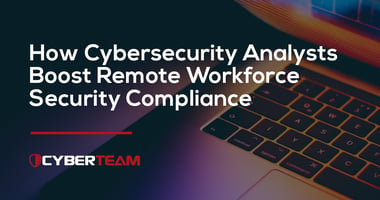The rise of the remote workforce over the last decade delivered cost-effective benefits to growing...
3 Mobile Device Security Best Practices For Enterprise Businesses
.jpeg?width=648&height=432&name=man%20looking%20at%20mobile%20device%20security%20(1).jpeg)
Between travel and the emergence of the remote workforce, an increased number of mobile devices are being used to check company email, complete projects, and video conference with colleagues. In many ways, the convenience of work-from-anywhere policies has outpaced the integration of mobile device security.
At CyberTeam, we work diligently with businesses to address mobile device security risks. We hope the following information will empower you to make informed decisions about managing remote workers in a secure fashion.
Why is Mobile Device Security Important?
Mobile device security involves the protection of smartphones, laptops, tablets, and other electronics, as well as their connecting networks. Securing mobile devices has become of paramount importance as companies reduce their brick-and-mortar presence in favor of a remote workforce.
According to the Bureau of Labor Statistics, approximately 27 percent of the U.S. workforce works outside the traditional office at least part-time. However, several academic studies indicate that number is closer to 50 percent. While tapping into talents outside the physical commuter radius proves beneficial for companies, remote connections typically expand the potential attacks surface hackers can exploit.
That’s why every unique endpoint device requires the same level of cybersecurity protection as on-site desktops. Furthermore, allowing employees the freedom to log into their business profiles from unvetted phones and iPads only exacerbates vulnerabilities.
What is a Common Mobile Device Security Threat?
It’s important to keep in mind that both mobile and desktop devices pose the same security risks. Cybercriminals are equally willing to target in-house computers as mobile devices. What the hacker is searching for is a security gap that opens the door to a data breach. These rank among the common threats.
Phishing Schemes: Hackers send out thousands of scam emails hoping to get someone to download a malware-laced file or click on a malicious link. This modus operandi has proven effective at infiltrating business networks and is unlikely to cease in the near future.
- Social Engineering: Hackers deploy a mix of emails and text messages in an effort to trick people into giving away username and password information. Some of these messages are convincing enough to work.
- Mobile Malware: Cybercriminals are slipping malware into seemingly safe apps. This part of the threat landscape is particularly challenging because security standards are not always followed when releasing phone apps.
- Public Wi-Fi: Even garden variety hackers know how to take advantage of people using unprotected public Wi-Fi. Techniques such as “spoofing” create a security certificate and look-alike networks that invite remote workers. Then, the digital thief uses what is called a man-in-the-middle attack.
Because hand-held electronics are not always equipped with enterprise-level defenses, upwards of 60 percent of digital fraud stems from mobile device breaches. Securing mobile devices tasks an organization with developing a determined cybersecurity posture and following best practices.
3 Mobile Device Security Best Practices
Companies that are willing to let staff members access their user profiles remotely must implement robust cybersecurity measures, coupled with mobile device security best practices. These rank among the best practices and tools to ensure security for mobile devices.
1: Approved Mobile Devices
It’s essential to have a policy that only allows fully vetted devices to access the organization’s network. These must be outfitted with the latest defensive applications and equipped to encrypt electronic messages. Using untested and vulnerable devices creates security gaps.
2: Endpoint Monitoring
Expanding the threat monitoring capabilities to approved mobile devices helps secure the virtual network perimeter. Constantly scanning for unusual activity and anomalies using AI identifies potential threats. Alerts can be automatically sent to your cybersecurity team.
3: Virtual Private Network
Commonly called a “VPN,” this safeguard provides remote workers with a secure connection. It eliminates the need to use public Wi-Fi landscapes that are tantamount to hacker hunting grounds. Your VPN can also include encryption capabilities to add another level of security when transferring files.
There are also internal policies and best practices that can minimize risk. Multi-factor authentication, for example, requires legitimate users to enter a code sent to a secondary source before entering the system. And, zero trust policies limit each user profile to only necessary applications and digital assets. If you are concerned about your cybersecurity program’s ability to protect against endpoint intrusions, it’s time to have it assessed.
Get A Mobile Device Security Risk Assessment
At CyberTeam, our managed IT and cybersecurity consulting experts have the experience and technology to protect your mobile devices and business network. We start by conducting a risk assessment to gain a clear understanding of your system’s strengths and vulnerabilities. Schedule a risk assessment with us and let’s get the process started.





